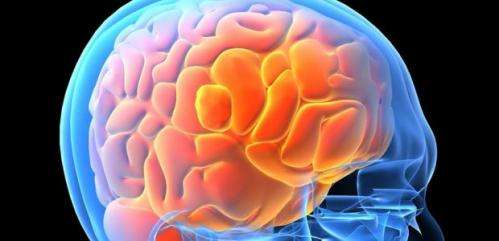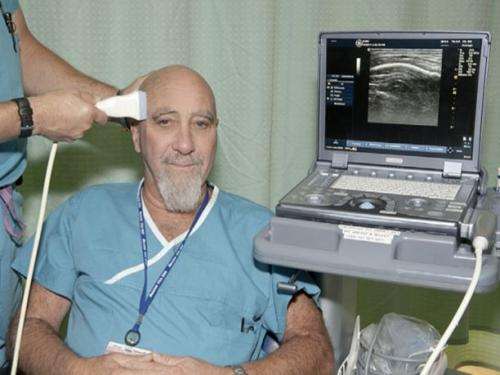Good vibrations: Mediating mood through brain ultrasound

University of Arizona researchers have found in a recent study that ultrasound waves applied to specific areas of the brain are able to alter patients' moods. The discovery has led the scientists to conduct further investigations with the hope that this technique could one day be used to treat conditions such as depression and anxiety.
Dr. Stuart Hameroff, professor emeritus of the UA's departments of anesthesiology and psychology and director of the UA's Center for Consciousness Studies, is lead author on the first clinical study of brain ultrasound, which was published in the journal Brain Stimulation.
Hameroff became interested in applying ultrasound to the human brain when he read about a study by colleague Jamie Tyler at the Virginia Polytechnic Institute, who found physiological and behavioral effects in animals of ultrasound applied to the scalp, with the waves passing through the skull.
Hameroff knew that ultrasound vibrates in megahertz frequencies at about 10 million vibrations per second, and that microtubules, protein structures inside brain neurons linked to mood and consciousness, also resonate in megahertz frequencies. Hameroff proposed testing ultrasound treatment for mood on human brains.
"I said to my anesthesiology colleagues, 'we should try this on chronic pain patient volunteers.'" His colleagues respectfully suggested he try it on himself first. Hameroff acquiesced.
After 15 seconds with an ultrasound transducer, a standard ultrasound imaging device, placed against his head, Hameroff felt no effect.
"I put it down and said, 'well, that's not going to work,'" he said. "And then about a minute later I started to feel like I'd had a martini."
His mood was elevated for the next hour or two, Hameroff said. Aware that his experience could be a placebo effect, an imagined effect derived from his expectation to feel a change, Hameroff set out to properly test the treatment with a clinical trial.
With research committee and hospital approval, and patient informed consent, Hameroff and his colleagues applied transcranial ultrasound to chronic pain patients at The University of Arizona Medical Center-South Campus, in a double blind study in which neither doctor nor subject knew if the ultrasound machine had been switched on or off.

Patients reported improvements in mood for up to 40 minutes following treatment with brain ultrasound, compared with no difference in mood when the machine was switched off.
"Encouraging!" Hameroff remarked. "We're referring to transcranial ultrasound as 'TUS,'" he said. "Which is also the airport code for Tucson."
The discovery opens the door to a possible range of new applications of ultrasound in medicine.
"We frequently use ultrasound in the operating room for imaging," said Hameroff. "It's safe as long as you avoid excessive exposure and heating."
The mechanical waves, harmless at low intensities, penetrate the body's tissues and bones, and an echo effect is used to generate images of anatomical structures such as fetuses in the womb, organs and blood vessels.
Additionally, the high-frequency vibrations of ultrasound, which far exceed the range of human hearing and are undetectable when passing through the body, may be more desirable than existing brain stimulation techniques such as transcranial magnetic stimulation, or TMS. Used to treat clinically depressed patients, TMS can have side effects including the unpleasant sensation of magnetic waves moving through the head.
However, "the Brain Stimulation study wasn't very well designed because I'm not a skilled clinical psychologist, plus we were very limited in clinic time," Hameroff said. "So I got two of my colleagues, Jay Sanguinetti and John Allen, to join in and help out."
Sanguinetti, a doctoral candidate in the department of psychology and his adviser Allen, a UA distinguished professor of psychology, were intrigued by Hameroff's idea of testing ultrasound.
They conducted an initial study of ultrasound on UA psychology student volunteers, recording vital signs such as heart rate and breath rate, and narrowed down the optimum treatment to 2 megahertz for 30 seconds as the most likely to produce a positive mood change in patients.
"With 2 megahertz those who were stimulated with ultrasound reported feeling 'lighter,' or 'happier;' a little more attentive, a little more focused and a general increase in well-being," Sanguinetti said.
Allen and Sanguinetti then began a double blind clinical trial to verify the statistical significance of their findings and to rule out any possibility of a placebo effect in their patients. Results of the trials are being analyzed, Sanguinetti said.
"What we think is happening is that the ultrasound is making the neurons a little bit more likely to fire in the parts of the brain involved with mood," thus stimulating the brain's electrical activity and possibly leading to a change in how participants feel, Sanguinetti said.
The UA researchers are collaborating with the Silicon Valley-based company Neurotrek, which is developing a device that potentially could target specific regions of the brain with ultrasound bursts.
The UA researchers will work with a prototype of the Neurotrek device to test its efficacy and potential applications.
"The idea is that this device will be a wearable unit that noninvasively and safely interfaces with your brain using ultrasound to regulate neural activity," Sanguinetti said.
More information: www.quantumconsciousness.org/d … ents/TUSinpress2.pdf


















